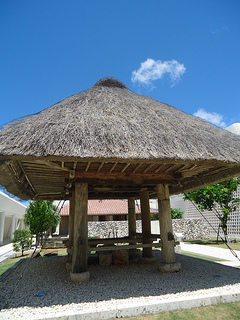
- For the monarch, see Emperor Takakura
- Japanese: 高倉 (takakura)
A takakura (lit. "tall/high storehouse") is a style of elevated storehouse, common throughout the Japanese archipelago in prehistoric and early historic times, and used in the Ryûkyû Islands into the 20th century. Similar structures are seen in Indonesia, and elsewhere throughout the Southeast and East Asian region.
A Ryukyuan or Amami Islands storehouse is typically comprised of a single storage space with an extensive thatched roof, elevated off the ground on a series of wooden pillars. The elevation protects the crops contained within from humidity and from vermin. An example at the Okinawa Prefectural Museum, dating to the Shôwa period (1926-1989) and originally built on Okinoerabu Island, is 6.45 meters in total height, elevated on six pillars separated by 3.16 meters in one direction, and 2.35 meters in the other direction, covering a total of 7.4 square meters.
References
- Plaques on-site at Edo-Tokyo Open Air Architectural Museum and Okinawa Prefectural Museum.